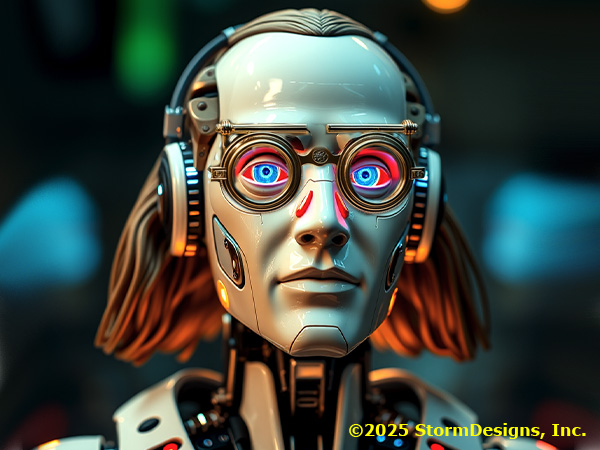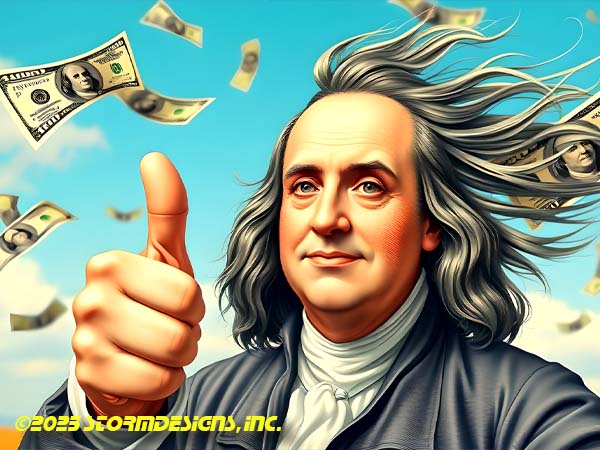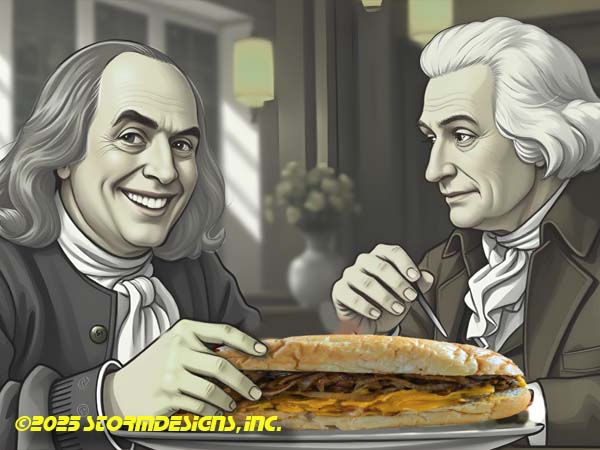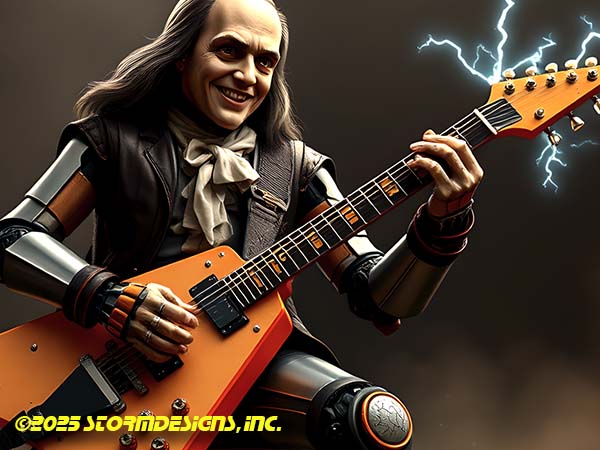How Bifocals Came to Be...

How did Ben develop bifocals?
👓 The Backstory of Franklin’s Bifocals
By the time Franklin invented bifocals (around 1784, when he was in his late 70s), he had been struggling with presbyopia—the age-related condition that makes it harder to focus on close-up objects. He already wore two pairs of glasses—one for reading and one for distance—but hated having to switch them constantly. His solution? Combine them.
He wrote to friends about this idea, describing how he had the upper half of each lens ground for distance vision and the lower half for reading. His letter to London scientist George Whatley in 1785 casually mentions:
"I have only to move my eyes up or down, as I want to see distinctly far or near, the proper glasses being always ready."
That’s Ben—just casually inventing multitasking eyeballs.
🔍 So Who Made the Lenses?
Since Franklin wasn’t a craftsman, he worked with skilled opticians and glass grinders in both Philadelphia and London. Unfortunately, he didn’t record exactly who made that first bifocal pair, but two notable possibilities are:
-
Samuel Piercy, a London optician who served Franklin during his time in Europe.
-
David Rittenhouse, a Philadelphia-based polymath and instrument maker who was friends with Franklin and capable of precision work. Some historians believe he could have helped Franklin prototype ideas like this.
Franklin’s letters suggest he personally commissioned the first pair to suit his own needs—so yes, they were absolutely for personal use first, not a public invention. It wasn't until decades later that bifocals became more commonly produced and refined.
🧠 Bonus Franklin-ism
In typical Franklin fashion, he didn’t patent the idea. He believed inventions should serve the public good, not line pockets. He once wrote:
“As we enjoy great advantages from the inventions of others, we should be glad of an opportunity to serve others by any invention of ours.”
Classic Ben—equal parts inventor, philosopher, and benevolent DIY wizard.
Want to explore more about Franklin’s European collaborations or how bifocals evolved after him?
Of course, here at StormDesigns we appreciate the connection he has to our region in Philadelphia, Innovation and that famous thunderstorm where he discovered the key to electrical conductivity.
But the real question is where did it start? How do we ordinary folks tap into our inner “Benjamin” and start earning Big Benjamin$ for our life, our families and our vision!? Let's look at his history to inspire in that direction.
BrainStorm
Design
Develop
Implement
General History
General History
Benjamin (no middle name!?) Franklin was born on January 17, 1706, in Boston, Massachusetts, to a large and modest Puritan family.

Benjamin (no middle name!?) Franklin was born on January 17, 1706, in Boston, Massachusetts, to a large and modest Puritan family.
The 15th of 17 children (!!), he was born to Josiah Franklin, a candle and soap maker, and his second wife, Abiah Folger. Franklin's upbringing was shaped by a hardworking, frugal, and religious household, emphasizing discipline and self-improvement.
Childhood and Home Life:
-
Large Family: With so many siblings, Franklin grew up in a bustling household where resources were stretched thin but influences and learning experiences were plentiful.
-
Limited Formal Education: He attended the Boston Latin School for only a couple of years before his father pulled him out at age 10 to work in the families candle-making business.
-
Apprenticeship: At 12, he was apprenticed to his older brother James, a printer. This exposed him to books, newspapers, and the world of publishing. All were very critical to his later success! His young apprenticeships served him well. If you're trying to influence any young people in your life, find things that interest them and perhaps match them to trustworthy grown-ups who'd love a young helper!
Earliest Influences:
-
His Father, Josiah Franklin: Taught him the value of hard work, thrift, and self-discipline.
-
His Brother James Franklin: As a printer and publisher of The New-England Courant, James introduced Franklin to writing and the printing trade. Their relationship was strained, but this experience was formative.
-
Books and Self-Education: Franklin was an avid reader, consuming works on science, philosophy, and literature. He admired writers like Plutarch and Cotton Mather.
-
Silence Dogood Letters: At age 16, he wrote satirical essays under the pseudonym "Silence Dogood," mocking colonial society. This early writing career helped develop his wit and persuasive skills.
-
Boston's Intellectual Climate: Growing up in Puritan New England, Franklin was surrounded by religious and intellectual debates, influencing his later views on reason and tolerance.

Though Franklin’s childhood was one of modest means and strict discipline, it laid the foundation for his later success as an inventor, writer, and statesman.
His self-taught education and exposure to printing shaped him into one of the most influential figures in American history.
Most Noted Inventions
The “Franklin Stove“, the Lightning Rod, Bifocal Glasses...
Benjamin Franklin‘s first noted invention was the Franklin Stove, also known as the Pennsylvania Fireplace, which he designed in 1742. This cast-iron stove was created to improve heating efficiency in colonial homes while using less firewood than traditional fireplaces.
Why It Was Important:
-
It produced more heat while reducing smoke in homes.
-
It used less wood, making it more efficient and economical.
-
The design included a baffle system that improved airflow and heat retention.
Despite its success, Franklin never patented the stove because he believed in the free exchange of ideas for the betterment of society. This philosophy extended to many of his later inventions, like the lightning rod and bifocal glasses.
More detailed list of his Inventions:
Benjamin Franklin was known for his practical inventions that improved everyday life. While there isn't an exact number, he is credited with inventing or significantly improving at least a dozen notable devices. Here’s a list of his most famous inventions:
-
Lightning Rod (1752) – Protected buildings from lightning strikes by directing electricity safely into the ground.
-
Bifocal Glasses (Around 1784) – Allowed people with both nearsightedness and farsightedness to see clearly with a single pair of glasses.
-
Franklin Stove (1742) – A more efficient heating stove that provided better heat output while using less wood.
-
Glass Armonica (1761) – A musical instrument that produced ethereal sounds by spinning glass bowls of different sizes.
-
Flexible Urinary Catheter (1752) – A smoother, more comfortable catheter designed to help those with bladder issues.
-
Swim Fins (1717) – Hand paddles for swimming to increase speed, designed when Franklin was a young boy.
-
Odometer for Carriages (1750s) – Measured the distance traveled by carriages, which he used to improve postal routes.
-
Long Arm (1780s) – A device with a grabber at the end to reach books on high shelves.
-
Three-Wheel Clock (1757) – A simplified clock with fewer moving parts, making it more reliable.
-
Reforms in Street Lighting (1757) – He improved streetlamp design by adding better ventilation to reduce soot buildup.
Influence Beyond Physical Inventions:
Though not physical inventions, Franklin also contributed to:
-
Daylight Saving Time (as an idea to conserve candles)
-
The American Fire Department (co-founded the first volunteer fire company)
-
Public Lending Libraries (helped establish the first in America)
-
The First Public Hospital (co-founded Pennsylvania Hospital)
Been Jammin'?

Franklin never patented his inventions, believing that knowledge should be freely shared for the benefit of society.
While we're not anti-patent or copyright for inventions we appreciate the generosity and purposefulness of his "Brand". Today's designs and inventions take a lot of work and expense most sadly can't give away or they would never happen.
This was truly a kind and good man deserving of his esteemed standing in our history. Let's get inspired to be as productive and positive as Benjamin! (BeenJammin!)
The Goals of our BrainStorm
- Determine how we can best benefit your needs.
- Learn about your business
- Share technology ideas and success models
- develop one or more personae for visual language targeting
- Create an energizing plan of action
- Execute on that plan.